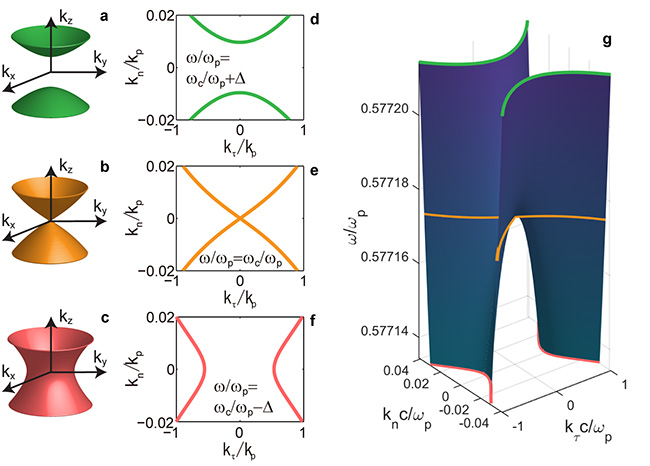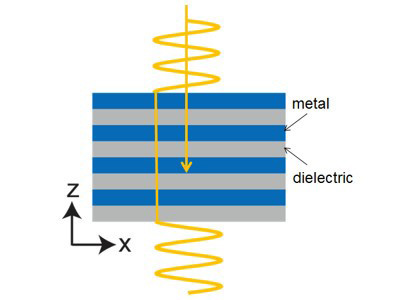A new class of optical topological transitions in electromagnetic metamaterials induced by the non-locality of the electromagnetic response is reported.

Figure 1: a-f, Iso-frequency curves of the multilayer HMM in kx-ky-kz space (a-c) and in kτ-kn space (d–f) at ω/ωp = ωc/ωp+Δ (a, d), ω/ωp = ωc/ωp (b, e) and ω/ωp = ωc/ωp−Δ (c, f). Panel (g) shows the evolution of iso-frequency curve with frequency, in the range ωc/ωp−Δ ≤ ω/ωp ≤ ωc/ωp+Δ. The iso-frequency curves in panels d-f are superimposed in panel g with the same colors. Throughout the entire plot, c is the speed of light, ωp is the plasma frequency of the metal layer consisting HMM, kp = ωp/c and Δ = 2.5×10-5.

Figure 2: Schematic of light propagating through a hyperbolic metamaterial (HMM) in a critical state where the effective refractive index is zero. Blue and gray stripes represent metal and dielectric layers, respectively.
Materials scientists can produce sub-wavelength artificial structures (split rings, honeycomb shapes and many more) to interact with electromagnetic waves so that the propagation of waves can be arbitrarily controlled to achieve desired effects. Among the myriad of these ‘metamaterials’, metal-dielectric periodic multilayers--hyperbolic metamaterials (HMMs)--are of particular interest. In spite of their simple structure, HMMs have the potential for unique optical applications including super-resolution lens, sub-wavelength interference and enhancing the emission of single-photon sources.
Now, Satoshi Ishii, at the International Center for Materials Nanoarchitectonics (MANA), NIMS, and Evgenii Narimanov at Purdue University, USA, analytically describe non-local optical topological transition in HMMs for the first time and unveil unique optical properties at the critical states.
So far, most researchers have treated HMMs as effectively homogenous media based on effective medium theory. Following this theory, an HMM behaves either like a ‘metal’ (reflects light) or like a ‘dielectric’ (refracts light in the negative direction) depending on the frequency of incident light.
In this research, the scientists succeeded in analytically demonstrating the transition between these two types of states induced by the non-local topological transition (see Figure 1). Furthermore, they found that in response to incoming light at the critical state, an HMM exhibits peculiar optical properties such that its effective refractive index is zero (see Figure 2) and the refraction becomes conical.
Based on these findings, the team is going to apply HMMs for the development of novel nanophotonic elements and photonic integrated circuits by an in-depth analysis of the critical states caused by the non-local topological transitions.
"Non-local Optical Topological Transitions and Critical States in Electromagnetic Metamaterials"
Satoshi Ishii and Evgemii Narimanov
Journal : Scientific Reports 5 (2015) 17824.
DOI :
10.1038/srep17824
International Center for Materials Nanoarchitectonics (WPI-MANA), National Institute for Materials Science (NIMS), Namiki 1-1, Tsukuba, Ibaraki 305-0044, Japan
References
"Non-local Optical Topological Transitions and Critical States in Electromagnetic Metamaterials", Satoshi Ishii and Evgemii Narimanov, Scientific Reports, 5 (2015) 17824. DOI: 10.1038/srep17824
ナノアーキテクトニクス材料研究センター(MANA)
〒305-0044 茨城県つくば市並木1-1
TEL: 029-860-4710
E-mail: mana-pr=ml.nims.go.jp([ = ] → [ @ ] )
To receive our e-mail newsletter “MANA Research Highlights”, please send an e-mail with "MANA Research Highlights request” in the subject line or main text to the following address: mana-pr_at_ml.nims.go.jp
*Please change "_at_ " in the email address to @.
 Research Highlights
Research Highlights


